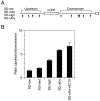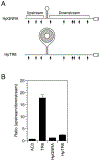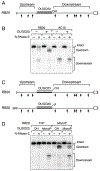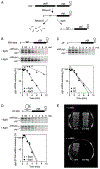Obstacles to Scanning by RNase E Govern Bacterial mRNA Lifetimes by Hindering Access to Distal Cleavage Sites
- PMID: 30852060
- PMCID: PMC6541411
- DOI: 10.1016/j.molcel.2019.01.044
Obstacles to Scanning by RNase E Govern Bacterial mRNA Lifetimes by Hindering Access to Distal Cleavage Sites
Abstract
The diversity of mRNA lifetimes in bacterial cells is difficult to reconcile with the relaxed cleavage site specificity of RNase E, the endonuclease most important for governing mRNA degradation. This enzyme has generally been thought to locate cleavage sites by searching freely in three dimensions. However, our results now show that its access to such sites in 5'-monophosphorylated RNA is hindered by obstacles-such as bound proteins or ribosomes or coaxial small RNA (sRNA) base pairing-that disrupt the path from the 5' end to those sites and prolong mRNA lifetimes. These findings suggest that RNase E searches for cleavage sites by scanning linearly from the 5'-terminal monophosphate along single-stranded regions of RNA and that its progress is impeded by structural discontinuities encountered along the way. This discovery has major implications for gene regulation in bacteria and suggests a general mechanism by which other prokaryotic and eukaryotic regulatory proteins can be controlled.
Keywords: 5′ terminus; RNA decay; RNA processing; RNase G; SgrS; phosphosugar stress; ribonuclease; ribosome; uORF; yigL.
Copyright © 2019 Elsevier Inc. All rights reserved.
Conflict of interest statement
DECLARATION OF INTERESTS
The authors declare no competing interests.
Figures







Similar articles
-
Graded impact of obstacle size on scanning by RNase E.Nucleic Acids Res. 2023 Feb 22;51(3):1364-1374. doi: 10.1093/nar/gkac1242. Nucleic Acids Res. 2023. PMID: 36620905 Free PMC article.
-
Influence of translation on RppH-dependent mRNA degradation in Escherichia coli.Mol Microbiol. 2012 Dec;86(5):1063-72. doi: 10.1111/mmi.12040. Epub 2012 Oct 9. Mol Microbiol. 2012. PMID: 22989003 Free PMC article.
-
In vitro analysis of mRNA processing by RNase E in the pap operon of Escherichia coli.Mol Microbiol. 1996 Jul;21(1):55-68. doi: 10.1046/j.1365-2958.1996.6121101.x. Mol Microbiol. 1996. PMID: 8843434
-
Messenger RNA degradation in bacterial cells.Annu Rev Genet. 2014;48:537-59. doi: 10.1146/annurev-genet-120213-092340. Epub 2014 Oct 1. Annu Rev Genet. 2014. PMID: 25292357 Free PMC article. Review.
-
Regulatory RNAs and target mRNA decay in prokaryotes.Biochim Biophys Acta. 2013 Jun-Jul;1829(6-7):742-7. doi: 10.1016/j.bbagrm.2013.02.013. Epub 2013 Mar 14. Biochim Biophys Acta. 2013. PMID: 23500183 Review.
Cited by
-
Bacterial ribonucleases and their roles in RNA metabolism.Crit Rev Biochem Mol Biol. 2019 Jun;54(3):242-300. doi: 10.1080/10409238.2019.1651816. Crit Rev Biochem Mol Biol. 2019. PMID: 31464530 Free PMC article. Review.
-
Improved RNA stability estimation through Bayesian modeling reveals most Salmonella transcripts have subminute half-lives.Proc Natl Acad Sci U S A. 2024 Apr 2;121(14):e2308814121. doi: 10.1073/pnas.2308814121. Epub 2024 Mar 25. Proc Natl Acad Sci U S A. 2024. PMID: 38527194 Free PMC article.
-
Unraveling the interplay between a small RNA and RNase E in bacteria.Nucleic Acids Res. 2024 Aug 27;52(15):8947-8966. doi: 10.1093/nar/gkae621. Nucleic Acids Res. 2024. PMID: 39036964 Free PMC article.
-
The small non-coding RNA B11 regulates multiple facets of Mycobacterium abscessus virulence.PLoS Pathog. 2023 Aug 21;19(8):e1011575. doi: 10.1371/journal.ppat.1011575. eCollection 2023 Aug. PLoS Pathog. 2023. PMID: 37603560 Free PMC article.
-
Hfq-Antisense RNA I Binding Regulates RNase E-Dependent RNA Stability and ColE1 Plasmid Copy Number.Int J Mol Sci. 2024 Apr 2;25(7):3955. doi: 10.3390/ijms25073955. Int J Mol Sci. 2024. PMID: 38612765 Free PMC article.
References
-
- Antson AA, Dodson EJ, Dodson G, Greaves RB, Chen X, and Gollnick P (1999). Structure of the trp RNA-binding attenuation protein, TRAP, bound to RNA. Nature 401, 235–242. - PubMed
-
- Båga M, Göransson M, Normark S, and Uhlin BE (1988). Processed mRNA with differential stability in the regulation of E. coli pilin gene expression. Cell 52, 197–206. - PubMed
Publication types
MeSH terms
Substances
Grants and funding
LinkOut - more resources
Full Text Sources
Molecular Biology Databases

